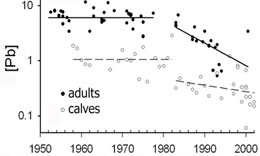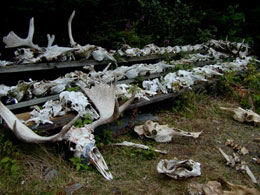
For many decades, we have been polluting our air with, among other toxins, mercury and lead. These pollutants eventually fall from the atmosphere and contaminate the Earth’s land and water. During the environmental movement of the 1970s, anti-pollution regulations, like the US Clean Air Act of 1970 and the removal of lead from gasoline, first mandated in 1975, were enacted in Canada and the United States. By the early 1980s, the concentrations of lead and mercury in the atmosphere over eastern North America had declined significantly.

However, it remains difficult to assess whether current air pollution regulations have adequately reduced mercury and lead contamination in terrestrial ecosystems. One of the great difficulties is that for most places that can be easily monitored, lead and mercury contamination is heavily influenced, not by region-wide levels of pollution, but by local point sources of pollution, like individual factories.
Isle Royale is an ideal place to observe declines in mercury and lead because there are no local point sources and Lake Superior has a large airshed. That is, about 90% of the mercury that is deposited into Lake Superior comes from more than 200 kilometers away from the shoreline.  This means that any decline in mercury would represent declines in pollution over a large region, not just changes in a single point source of pollution.
This means that any decline in mercury would represent declines in pollution over a large region, not just changes in a single point source of pollution.
Although Isle Royale would be an ideal place to monitor mercury and lead pollution, no one monitored these pollutants before or after the enactment of anti-pollution regulations. Nevertheless, the concentrations of mercury and lead in the Isle Royale ecosystem have been recorded each year in the teeth of Isle Royale’s moose that we’ve been collecting for each of the past five decades. Once mercury or lead was deposited from the atmosphere onto vegetation, it was consumed by moose. Then, by a complex set of physiological processes, some of it was incorporated, permanently, into the teeth of moose. There the mercury  and lead remained sealed in enamel until we collected and analyzed it.
and lead remained sealed in enamel until we collected and analyzed it.
Through collaboration with Peter Outridge (Geological Survey of Canada) and Rune Eide and Rolf Isrenn (both from University of Bergen, Norway), we measured the concentration of mercury and lead in the teeth of moose for which we knew the year of birth, thus the year when their teeth were formed. The moose we analyzed had lived in different years between 1952 and 2002. What we found is that mercury concentration dropped suddenly by about 65% in the early 1980s and has remained constant for the following two decades. Lead began declining in the early 1980s and continued declining throughout the next two decades. By 2002 lead concentrations in adult moose teeth were 80% lower than they had been prior to the early 1980s.

Mercury (Hg) and lead (Pb) concentrations before and after 1983 in Isle Royale moose teeth. The boxes represent inter-quartile ranges, the solid line is the median, dashed line is the mean, whiskers are 10th and 90th percentiles, open circles are data outside 10th and 90th percentiles. The units are mg/g dry weight.
The concentration of lead [Pb] in moose teeth was high and steady for 3 decades. Then in the early 1980s lead began to decline in both adult moose and calves.
These declines clearly indicate the value of our current anti-pollution regulations. One of the most important remaining questions is whether these reductions in pollution are sufficient. Science alone cannot answer that question.
Each year for the past five decades, the wolf-moose project has been collecting samples of the skeletal remains of each dead moose we have discovered. In total, we’ve collected samples from the bones of more than 4,000 different moose. These bones have been valuable for reasons that never could have been imagined when this collection first began.
